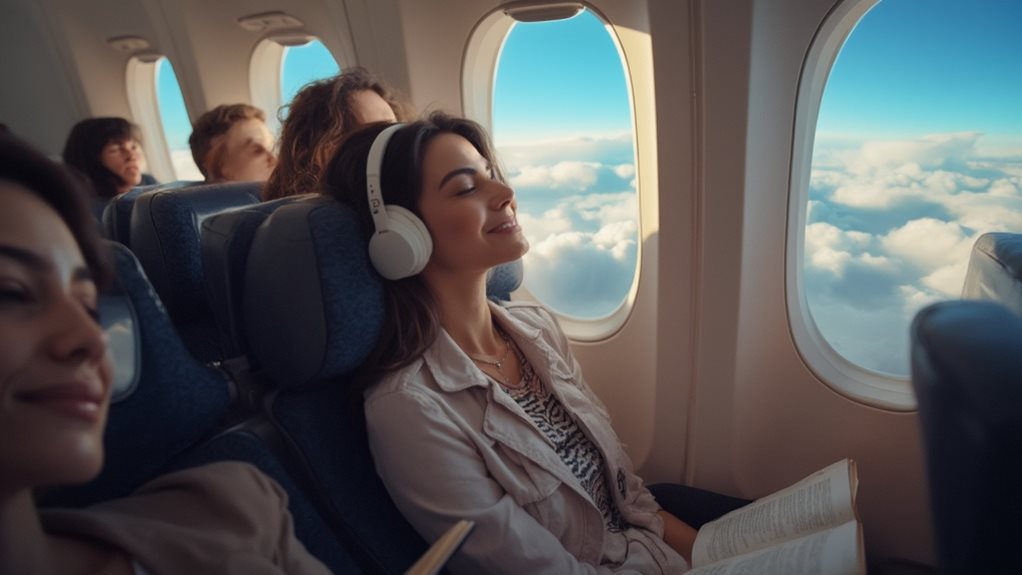
Fear of flying can be greatly reduced by employing techniques like hypnosis, Emotional Freedom Techniques (EFT), and Neuro-Linguistic Programming (NLP). These methods collaborate to relax the mind, release emotional stress, and transform negative thought patterns into positive affirmations. By approaching the fear from multiple angles, individuals build resilience and regain confidence. Exploring these strategies further offers the promise of a more relaxed and enjoyable flying experience, establishing newfound freedom in the skies.
Key Takeaways
- Identify psychological triggers and past experiences contributing to your fear of flying.
- Explore hypnosis to reprogram fear responses and promote deep relaxation.
- Utilize Emotional Freedom Techniques to manage anxiety by tapping on meridian points.
- Apply Neuro-Linguistic Programming to shift negative thought patterns and enhance mental resilience.
- Combine these techniques for a synergistic approach to build lasting confidence in flying.
Understanding the Roots of Fear of Flying
Understanding the roots of fear of flying is essential in addressing this common phobia effectively.
Often stemming from psychological triggers, the fear can be deeply rooted in past experiences. These may include previous traumatic flights or even stories heard from others which instill a sense of danger.
Recognizing these triggers allows individuals to confront and understand their fears better. By empathetically addressing these psychological aspects, one can start to disentangle the fear from the actual safety of flying.
This understanding is the first step towards reclaiming confidence and enjoying the freedom that comes with air travel.
How Hypnosis Can Transform Your Experience With Flying
Building on the foundation of recognizing psychological triggers, hypnosis emerges as a powerful tool in reshaping the experience of those who fear flying. This technique explores the subconscious, allowing for profound healing and the reprogramming of fear responses.
Hypnosis benefits are numerous: it fosters deep relaxation, fortifies mental resilience, and disrupts anxiety-producing patterns, paving the way for a calmer approach to air travel.
The Role of Emotional Freedom Techniques in Managing Flight Anxiety

While hypnosis explores the subconscious to alleviate the fear of flying, Emotional Freedom Techniques (EFT) offer a complementary approach that focuses on the physical manifestation of emotional distress.
By tapping on specific meridian points, EFT techniques facilitate an emotional release that can considerably reduce anxiety. This method allows individuals to address the layers of fear associated with flying, tapping into the body's energy system to restore balance and promote healing.
The process is gentle yet powerful, providing a pathway to reclaim emotional stability and fostering a sense of control over one's anxieties, making flying a more accessible and less intimidating experience.
Utilizing Neuro-Linguistic Programming to Change Your Mindset
Neuro-Linguistic Programming (NLP) often yields transformative results for those endeavoring to overcome their fear of flying. By employing techniques that facilitate mindset shifts and belief reframing, individuals can alter their internal representations of flying.
NLP strategies work by identifying negative thought patterns and replacing them with empowering beliefs. This process not only alleviates anxiety but also fosters a sense of control and safety.
Through visualization and positive language, NLP equips individuals with tools to mentally and emotionally prepare for flight. The ultimate goal is transforming fear into an opportunity for growth and confidence, making flying a more approachable experience.
Combining Techniques for Optimal Results

Many individuals grappling with a fear of flying find that a singular approach may not fully address their complex emotions and thought patterns. Integrative approaches create therapeutic synergy, enhancing the effectiveness of overcoming phobias. Below is a breakdown of how combining techniques can lead to ideal results:
| Technique | Benefit | Synergy Effect |
|---|---|---|
| Hypnosis | Deep relaxation | Enhances focus in EFT and NLP |
| EFT | Stress reduction | Supports emotional stability in NLP |
| NLP | Mindset shift | Strengthens resolutions formed in hypnosis |
| Combined | All-encompassing approach | Maximizes potential for lasting confidence |
This holistic strategy fosters a supportive and transformative journey towards fearless flying.
Success Stories From Those Who Overcame Their Fear
Although the journey may seem intimidating, success stories from individuals who have conquered their fear of flying are both inspiring and illuminating.
These personal journeys reveal a remarkable transformation, where fear is replaced by confidence through tailored interventions like hypnosis, EFT, and NLP. Each story underscores a unique pathway to empowerment, showcasing not just a triumph over fear, but a newfound freedom in travel and life.
Such accounts serve as a beacon of hope, reassuring others that their anxiety does not have to be a permanent fixture. Indeed, these narratives highlight resilience and the profound impact of dedicated fear-conquering strategies.
Strategies to Use Before and During Your Flight

Preparing effectively can greatly alleviate the anxiety associated with flying. Pre-flight preparation involves educating oneself about the flight process, arranging comforting items like music or books, and practicing relaxation techniques such as deep breathing or meditation.
During the journey, in-flight techniques play an essential role. Passengers may benefit from engaging in calming activities, such as listening to soothing music, practicing mindfulness, or using progressive muscle relaxation. These strategies help maintain a calm mindset, control breathing, and divert attention from anxiety triggers.
Frequently Asked Questions
Can Fear of Flying Affect Physical Health Over Time?
Fear of flying can indeed impact physical health, as chronic anxiety symptoms exacerbate stress, potentially leading to heart issues, weakened immune response, and fatigue. Effective stress management is vital in mitigating these effects.
How Often Should I Practice These Techniques for Best Results?
For ideal results, technique frequency and practice consistency are essential. Regular daily practice is recommended to effectively address and manage anxiety, reinforcing positive changes and ensuring steady progress in overcoming phobias.
Are There Age Restrictions for Using These Therapeutic Methods?
Maneuvering the landscape of therapeutic methods reveals no strict age boundaries. Age guidelines vary, ensuring treatment accessibility for most. These techniques are adaptable, offering a comforting, informed path to tranquility across diverse age groups.
What if I Have Multiple Phobias Including Fear of Flying?
When addressing multiple phobias, including fear of flying, integrated therapeutic techniques like hypnosis, EFT, and NLP can be effective in phobia management, offering a holistic approach to alleviate anxiety and enhance overall emotional resilience.
Can External Factors Like Weather Influence Flight Anxiety Levels?
External factors, such as adverse weather conditions and turbulence effects, can indeed heighten flight anxiety levels, influencing passengers' emotional responses. Understanding these influences can help in managing and mitigating flight-related anxieties effectively.
Conclusion
In a world where the skies are not a limit but a pathway, overcoming the fear of flying is akin to acquiring wings. Techniques like Hypnosis, EFT, and NLP are not just tools, but catalysts for profound transformation. They unveil the boundless horizons of the sky, turning erstwhile fearful flyers into audacious aviators. Embrace these methods, and watch your fears dissolve, replaced by a newfound freedom and a zest for the boundless adventures that await above the clouds.





